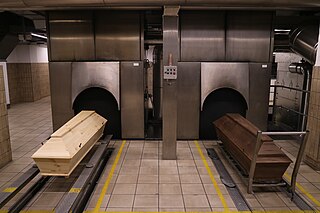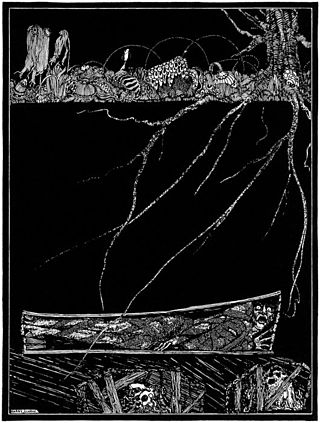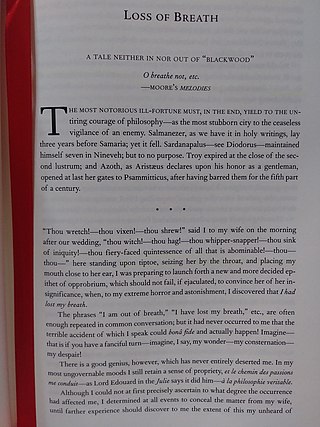Related Research Articles

A funeral is a ceremony connected with the final disposition of a corpse, such as a burial or cremation, with the attendant observances. Funerary customs comprise the complex of beliefs and practices used by a culture to remember and respect the dead, from interment, to various monuments, prayers, and rituals undertaken in their honor. Customs vary between cultures and religious groups. Funerals have both normative and legal components. Common secular motivations for funerals include mourning the deceased, celebrating their life, and offering support and sympathy to the bereaved; additionally, funerals may have religious aspects that are intended to help the soul of the deceased reach the afterlife, resurrection or reincarnation.

Cremation is a method of final disposition of a dead body through burning.

Burial, also known as interment or inhumation, is a method of final disposition whereby a dead body is placed into the ground, sometimes with objects. This is usually accomplished by excavating a pit or trench, placing the deceased and objects in it, and covering it over. A funeral is a ceremony that accompanies the final disposition. Humans have been burying their dead since shortly after the origin of the species. Burial is often seen as indicating respect for the dead. It has been used to prevent the odor of decay, to give family members closure and prevent them from witnessing the decomposition of their loved ones, and in many cultures it has been seen as a necessary step for the deceased to enter the afterlife or to give back to the cycle of life.
Embalming is the art and science of preserving human remains by treating them to forestall decomposition. This is usually done to make the deceased suitable for public or private viewing as part of the funeral ceremony or keep them preserved for medical purposes in an anatomical laboratory. The three goals of embalming are sanitization, presentation, and preservation, with restoration being an important additional factor in some instances. Performed successfully, embalming can help preserve the body for a duration of many years. Embalming has a very long and cross-cultural history, with many cultures giving the embalming processes a greater religious meaning.

Premature burial, also known as live burial, burial alive, or vivisepulture, means to be buried while still alive.

"The Premature Burial" is a horror short story by American writer Edgar Allan Poe, published in 1844 in The Philadelphia Dollar Newspaper. Its main character expresses concern about being buried alive. This fear was common in this period and Poe was taking advantage of the public interest. The story has been adapted to a film.

William Tebb was a British businessman and wide-ranging social reformer. He was an anti-vaccinationist and author of anti-vaccination books. He was concerned about premature burial.
Icelandic funerals are ceremonies that are largely shaped by the Evangelical Lutheran Church of Iceland, the largest Christian organisation in Iceland. However, customs may vary depending on religious group.

Taphophobia is an abnormal (psychopathological) fear of being buried alive as a result of being incorrectly pronounced dead.

A safety coffin or security coffin is a coffin fitted with a mechanism to prevent premature burial or allow the occupant to signal that they have been buried alive. A large number of designs for safety coffins were patented during the 18th and 19th centuries and variations on the idea are still available today.

Macabre is a 1958 American horror film directed by William Castle, written by Robb White, and starring William Prince and Jim Backus. The film falls into both the horror and suspense genres.

Legends of vampires have existed for millennia; cultures such as the Mesopotamians, Hebrews, ancient Greeks, and Romans had tales of demonic entities and blood-drinking spirits which are considered precursors to modern vampires. Despite the occurrence of vampire-like creatures in these ancient civilizations, the folklore for the entity known today as the vampire originates almost exclusively from early 18th-century Southeastern Europe, particularly Transylvania, Romania as verbal traditions of many ethnic groups of the region were recorded and published. In most cases, vampires are revenants of evil beings, suicide victims, or witches, but can also be created by a malevolent spirit possessing a corpse or a living person being bitten by a vampire themselves. Belief in such legends became so rife that in some areas it caused mass hysteria and even public executions of people believed to be vampires.

Hannah Beswick, of Birchin Bower, Hollinwood, Oldham, Greater Manchester, was a wealthy woman who had a pathological fear of premature burial. Following her death in 1758, her body was embalmed and kept above ground, to be periodically checked for signs of life.

The Premature Burial, also known as Premature Burial, is a 1962 American horror film directed by Roger Corman and starring Ray Milland, Hazel Court, Alan Napier, Heather Angel and Richard Ney. The screenplay by Charles Beaumont and Ray Russell is based upon the 1844 short story of the same name by Edgar Allan Poe. It was the third in the series of eight Poe-themed pictures, known informally as the "Poe Cycle", directed by Corman for American International Pictures.
The "Lady with the Ring" is a story about premature burial from European folklore. Versions of the story were popular throughout Europe in the 14th through the 19th centuries.

Imhotep is the main antagonist of the 1932 film The Mummy. He is also the main antagonist in the 1999 remake and its 2001 sequel The Mummy Returns. Sofia Boutella plays a female version of this character named Ahmanet in the 2017 reboot. Imhotep is loosely inspired by the historical figure Imhotep, a noted polymath and counselor to the Pharaoh Djoser in the 27th century BC.

During the Pre-Hispanic period the early Filipinos believed in a concept of life after death. This belief, which stemmed from indigenous ancestral veneration and was strengthened by strong family and community relations within tribes, prompted the Filipinos to create burial customs to honor the dead through prayers and rituals. Due to different cultures from various regions of the Philippines, many different burial practices have emerged. For example, the Manobos buried their dead in trees, the Ifugaos seated the corpse on a chari before it was brought to a cave and buried elsewhere. The most common forms of traditional burials are supine pits, earthenware jars, and log coffins, and have been a topic of interest among Philippine archaeologists since the early 20th century.
Burial in Anglo-Saxon England refers to the grave and burial customs followed by the Anglo-Saxons between the mid 5th and 11th centuries CE in Early Mediaeval England. The variation of the practice performed by the Anglo-Saxon peoples during this period, included the use of both cremation and inhumation. There is a commonality in the burial places between the rich and poor – their resting places sit alongside one another in shared cemeteries. Both of these forms of burial were typically accompanied by grave goods, which included food, jewelry, and weaponry. The actual burials themselves, whether of cremated or inhumed remains, were placed in a variety of sites, including in cemeteries, burial mounds or, more rarely, in ship burials.
The London Association for the Prevention of Premature Burial was an association that was co-founded in 1896 by William Tebb and Walter Hadwen. In the 1800s, it was not common nor mandatory for a physician to examine a body after death and declare the person deceased. The absence of a final check by a competent person for signs of life led to fears of premature burial. The London Association for the Prevention of Premature Burial was created to bring attention to the perceived problem of this state of affairs. The association campaigned for improvements in death certification and for the building of "safety coffins" with warning devices that could be activated by a person mistakenly declared dead and buried.

"Loss of Breath", also known as "Loss of Breath: A Tale Neither In Nor Out of 'Blackwood' ", is a short story written by American author Edgar Allan Poe under the pseudonym "Littleton Barry". A satirical tale, the story is narrated by Mr. Lackobreath who recounts his attempt to find and reclaim his lost breath, which he had literally misplaced. Throughout his journey, he is repeatedly dismembered and disfigured, falsely assumed to be dead, hanged, locked away, and prematurely interred. The absurd exaggerations may be explained by the fact that the tale was meant to satirize fiction published in the Edinburgh Blackwood Magazine, which was known for its sensational texts.
References
- ↑ (13 October 1912). Burial Alive is Bugaboo Of the Average Person, Washington Herald
- ↑ (1 August 1894). Put in Her Coffin Alive, Anderson Intelligencer
- ↑ (5 September 1894). Notes and Notions, Fort Wayne Gazette (one sentence report, states her age was 22 years old)
- ↑ (13 July 1932). Earth of Urn Burial, Burra Record (1932 mention of Markham's "amazing escape" from burial)
- ↑ (14 July 1894). From the Dead. A Supposed Corpse Comes to Life in the Coffin, Washington Bee
- ↑ (11 July 1894). From The Dead: A Supposed Corpse Comes to Life in the Coffin, Herkimer Democrat (Herkimer, New York), p. 2, col. 3
- ↑ Bryson, Bill. At Home: A Short History of Private Life (2010) (noting great concern in 19th century about risk of premature burial, and noting that Markham's 1894 event was a "well-known case")
- ↑ Tebb, William, et al. Premature Burial and how it May be Prevented, pp. 101–02 (1905)